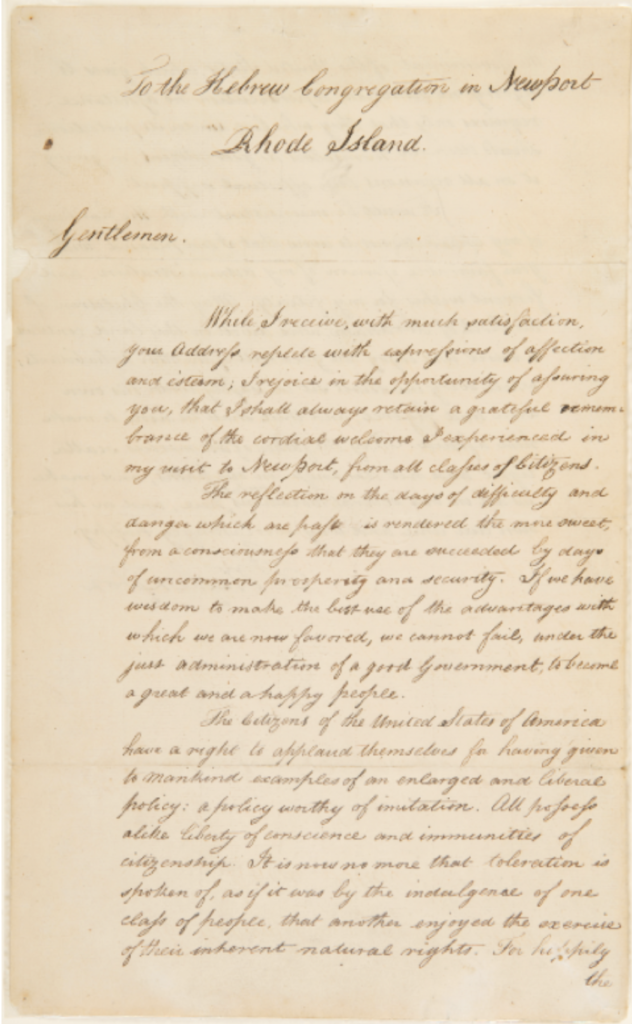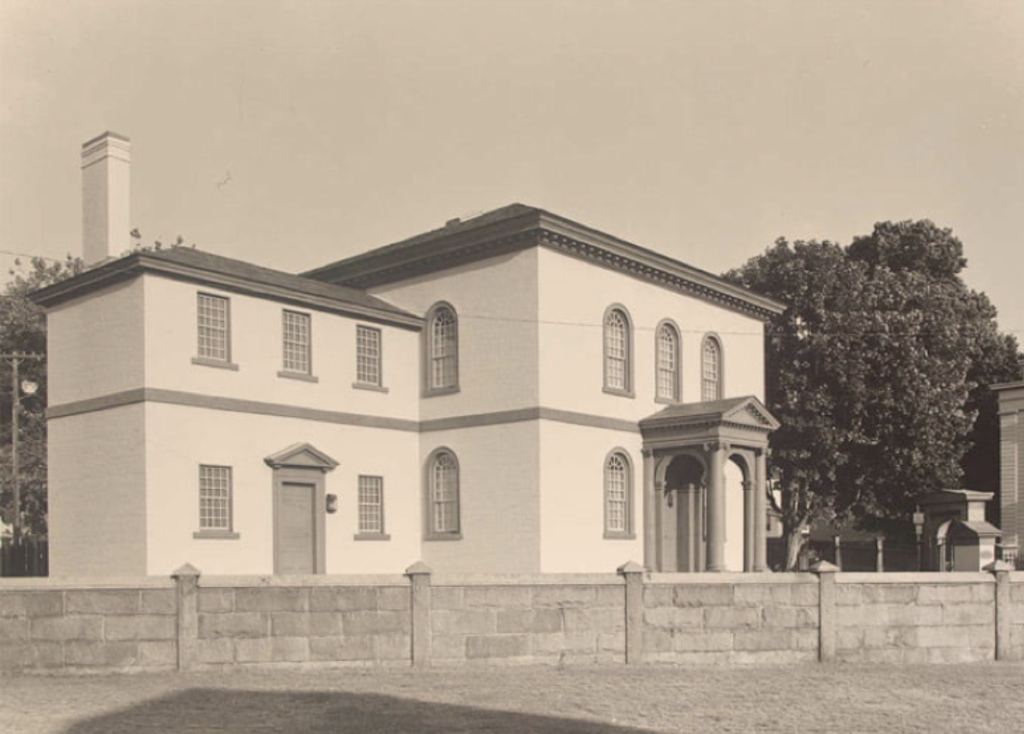History of Anti-Semitism
From the founding of our nation and through today, Jews, and unfortunately anti-semitism, have a woven story in our past.
Washington Proclamation at the Synagogue
In 1658, fifteen Sephardic families arrived in Newport, Rhode Island. By the Revolutionary War, the Newport Jewish community grew to be the largest in the colonies. On August 18, 1790, George Washington made an historic visit to Newport and met with Clergy, including members of Congregation Kahal Kadosh Yeshuat Israel and Newport merchant and banker Moses Seixas. On behalf of the congregation, Seixas wrote a welcoming letter to Washington and expressed the hopes of the Jewish community that the new government would be successful and its constitution would be committed to religious freedom…
“government erected by majesty of the people, a government which to bigotry gives no sanction, persecution no alliance, but generously affording to all Liberty of conscience…”
In response to Seixas letter, Washington assured the congregation that in his administration… “All possess alike liberty of conscience and immunities of citizenship”… and reiterated Seixas’ thoughts that “For happily the Government of the United States, which gives to bigotry no sanction, to persecution no assistance requires only that they who live under its protection should demean themselves as good citizens, in giving it on all occasions their effectual support.”
The original letter, owned by the Morris Morgenstern Foundation, is on long term loan to the National Museum of American Jewish History. Each year, members of the Touro Synagogue in Newport read the letter in a public ceremony.
On that day in August, 1790, Washington’s commitment to religious liberty, the involvement of all people in the new democracy and the campaign for the passage of the Bill of Rights began. A seminal letter to the Hebrew Congregations of Newport memorializes in a profound statement the values of the democracy.
First recorded act of anti-Semitism
The term anti-Semitism was coined in 1879 by the German agitator Wilhelm Marr to designate the anti-Jewish campaigns under way in central Europe at that time. In that year, Marr founded the Antisemites League and published a book called Victory of Jewry over Germandom.
In the first half of the 20th century, Jews in the United States faced discrimination in employment, in access to residential and resort areas, in the membership of clubs and organizations and in tightened quotas on Jewish enrollment and teaching positions in colleges and universities.
The Leo Frank Affair of 1915
In 1913, a 13-year-old child laborer at an Atlanta pencil factory named Mary Phagan was found dead in the factory’s basement. Leo Frank, the Jewish superintendent of the factory, was convicted of the crime and sentenced to death. In 1915, Georgia’s governor commuted Frank’s sentence to lifetime imprisonment due to a lack of sufficient evidence; Frank was abducted from prison and lynched. Despite the consensus among historians that Frank was innocent, as well as the corroborating claims of a witness. The controversial Frank case is credited with inspiring the resurgence of the Ku Klux Klan movement; it also played a role in the creation of the Anti-Defamation League in 1913.
Source: https://www.pbs.org/video/temple-150-leo-frank-case/
The KKK (Ku Klux Klan)
At the end of the Civil War, during reconstruction, the Klan mobilized as a vigilante group to intimidate Southern blacks and white sympathizers. Their outlandish titles, such as Imperial Wizard and Exalted Cyclops, hooded costumes, violent ‘night rides’ and the self professed notion of an ‘invisible empire’ brought a mystique and popularity to the Klan. Lynchings, tar and featherings, rapes and other violent attacks on anyone challenging white supremacy became the hallmark of the Klan.With the introduction of Jim Crow laws, the first era of the Klan ended.
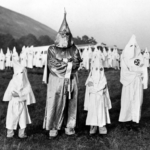
The Klan enjoyed a revival in the 1920s and added bias against Roman Catholics, Jews, foreigners and organized labor to their hostility toward blacks. By 1925, the Klan boasted of a membership of 4 million as well as political power. A burning cross became the symbol of the ‘new’ Klan. Their influence and members fell during the Great Depression as a result of sex scandals, internal battles and negative exposés. In the 1960s, the Klan again resurfaced to oppose the civil rights movement and to preserve segregation in the face of changing views, laws and unfavorable court rulings. The Klan again resorted to violence including bombings, murders and other violent attacks, many carried out in secret, that cost the lives of many.
In the years following, the Klan was again weakened by the growth of racial tolerance, internal conflicts, court loses and a series of splits and government infiltration. While some factions of the Klan remained openly racist and militant, others entered the mainstream by cloaking their racism as “civil rights for whites”.
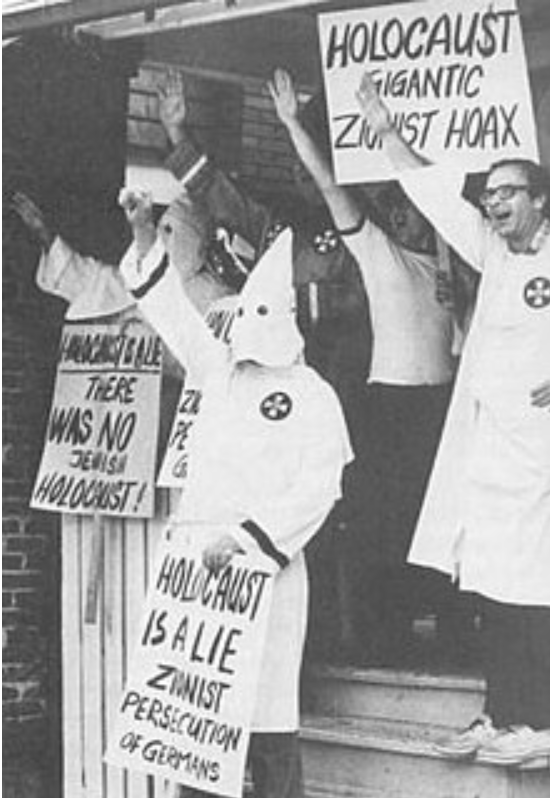
It is hard to determine actual current membership (some believe it to be between 5000-8000) in groups that call themselves “the Klan” as members are split among different and often warring factions.
In recent years, there has been a new resurgence of Klan-like groups as were seen in Charlottesville, with the Nazi originated chant “Jews will not replace us”, as well as in the increase in violence historically used by the Klan against African Americans, Jews and the “others ” in the form of bombings, shootings and terrorizing tactics.
Anti-Jew and Jim Crow
In 1935, Nazi Germany passed two pieces of legislation known as the Nuremberg Laws; the Reich Citizenship Law and the Law for the Protection of German Blood and German Honor. These laws were the foundation for the legal persecution of the Jewish people.
In their efforts to legally disenfranchise and discriminate against Jewish citizens, the Nazis looked to one source for inspiration – the United States of America. James Q. Whitman, a Yale Law School professor and author of “Hitler’s American Model”: “America in the early 20thcentury was the leading racist jurisdiction in the world. Nazi lawyers, as a result, were interested in, looked very closely at, (and) were ultimately influenced by American race law.” In particular, the Nazis admired the Jim Crow era laws that discriminated against, disenfranchised and segregated black Americans. However, the Nazis felt that the Jim Crow laws did not go far enough because according to Whitman; “One of the most striking Nazi views was that the Jim Crow was a suitable racist program in the United States because American blacks were already oppressed and poor…But in Germany, by contrast, where Jews (as the Nazis imagined) were rich and powerful, it was necessary to take more severe measures.” The Nazis showed a particular interest in how the US designated Native Americans, Filipinos and others as non citizens even though they resided in the US or its territories. The citizenship aspect of the Nuremberg Laws stripping Jewish Germans of citizenship used this US model.
One of the Jim Crow era laws that the Nazis wholeheartedly incorporated to ban Jewish and Aryan marriages were the anti-miscegenation laws in the US. The issue such laws presented the Nazis was how to determine who was Jewish. The anti-miscegenation laws dealt with this dilemma by adopting the “one-drop” rules that stipulated that anyone with any black ancestry was legally black and subject to anti-miscegenation laws. In order to criminalize marriage and sex between Jewish and Aryan people, the Nazis decreed that a Jewish person was anyone who had three or more Jewish grandparents.
In light of these Jim Crow era laws in effect at the time, it is not surprising that the Nazis were not uniformly condemned in the US.
American eugenicists welcomed Nazi ideas and the famous aviator Charles Lindberg accepted a swastika medal from the Nazi Party in 1938.
Upon entering the war, the US took a decidedly anti-Nazi stance. Recognizing the shared history of discriminatory laws, the program called “Double V Campaign” was launched. Its goal? Victory abroad against Axis powers and victory at home against Jim Crow.
Nazism in Madison Square Garden Rally
On February 20, 1939, Americans held a rally in New York City’s Madison Square Garden to celebrate the rise of Nazism in Germany. Organized by the German American Bund (Bund is German for federation) and advertised as a “Pro American Rally”. The German American Bund was an anti-Semitic organization known for sponsoring Nazi summer camps for youth and their families. About 20,000 attendees raised Nazi salutes toward a 30-foot tall portrait of George Washington flanked by swastikas.
Also in attendance were members of the Ordnungsdienst, the OD, whose vigilantes dressed in the style of Hitler’s SS officers. Banners at the rally read “Stop Jewish Domination of Christian Americans” and “Wake Up America. Smash Jewish Communism.” The Bund’s national leader, Fritz Kuhn, referred to President Franklin Roosevelt as “Rosenfield” and to Manhattan District Attorney Thomas Dewey as “Thomas Jewey.”
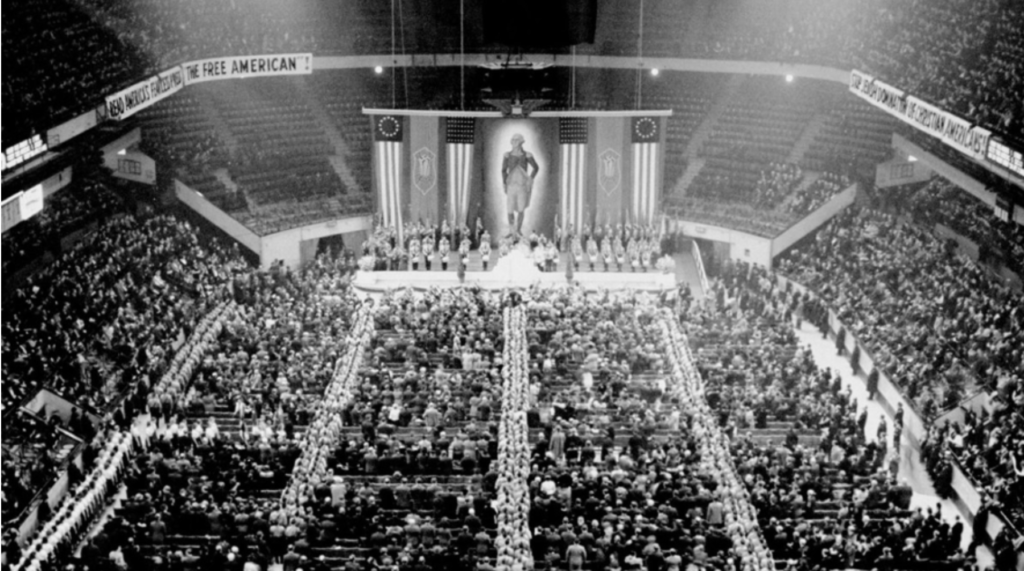
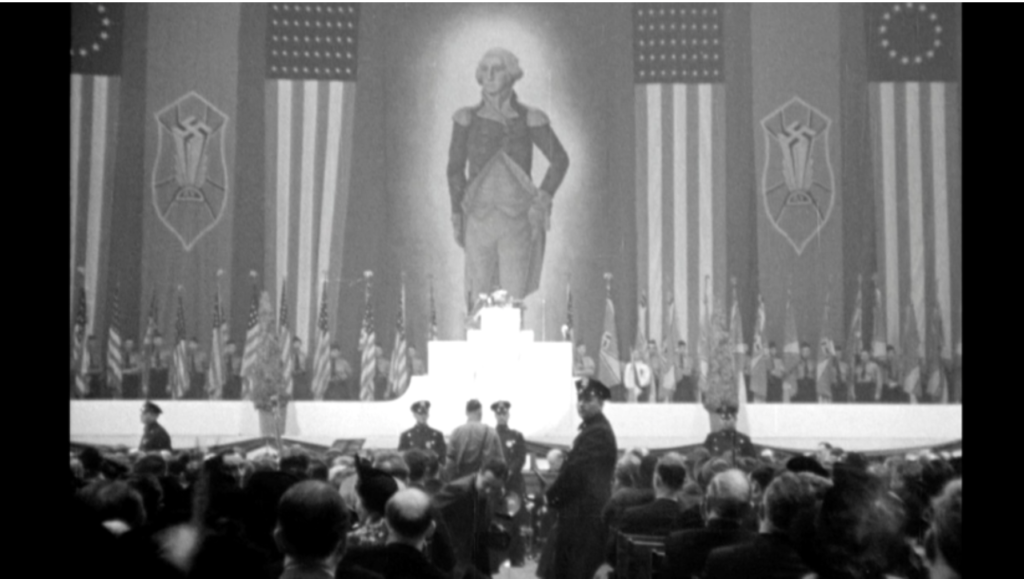
Kuhn, a naturalized American who lost his citizenship during World War II, addressed the rally stating, “If you ask what we are actively fighting for under our charter: First, a socially just, white, Gentile-ruled United States. Second, Gentile-controlled labor unions, free from Jewish Moscow-directed domination.” Kuhn’s speech was interrupted by Isadore Greenbaum who was attacked by the vigilante forces and police and charged with disorderly conduct and fined.
Outside the rally were about 100,000 protesters carrying signs and messages warning that what was happening in Nazi Germany could also happen in America. “Don’t wait for the concentration camps-Act Now!” “Smash Anti-Semitism”. In some cases, the police responded to the protesters with violent attacks.
US Government refuses entry to Jewish Refugees on the M.S. St. Louis
In May 1939, the German liner M.S. St. Louis sailed from Hamburg, Germany to its destination of Havana, Cuba. The St. Louis carried 937 passengers, almost all Jewish refugees. The Cuban government had issued landing permits to the St. Louis. However, when the St. Louis arrived in Havana, the Cuban government cancelled the landing permits. Negotiations between the American Jewish Joint Distribution Committee (JDC) and the Cuban government failed and the ship was forced to leave Havana harbor.
Despite pleas to the US, the US government refused to allow the passengers to land in the US since they did not have US immigration visas and had not passed a security screening. Canada was also unwilling to admit the passengers. The St. Louis was forced to return to Europe. Great Britain, France, Belgium and the Netherlands each admitted some of the passengers, and some passengers were eventually able to obtain US immigration visas. 254 passengers of the ill-fated St. Louis were murdered in the Holocaust.

Anti-Semitism at the UN
In 1975, the United Nations put up to vote a blatantly anti-Semitic resolution meant to attack the Jewish state of Israel. The resolution equated Zionism to a form of racism. Despite an impassioned speech by US ambassador Daniel Patrick Moynihan condemning the resolution, it passed by a vote of 72-35.
The anti-Semitic resolution was revoked by the United Nations in 1991.
Crown Heights Riots
Despite living side by side in the Crown Heights area of Brooklyn, New York, Hasidic Jews, African Americans and people from the Caribbean rarely socialized, lived in separate cultural worlds and there was a climate of mutual suspicion and tension. On August 19, 1991, Rabbi Menachem Schneerson, the spiritual leader of the Lubavitch Hasidic movement, visited the Old Montefiore Cemetery in Queens. On the return to Crown Heights from the cemetery, Rabbi Schneerson’s vehicle was followed by a police car and a vehicle containing four young members of the Hasidic community.
Tragically, the vehicle containing the young Hasidic members, either proceeded through a yellow light or ran a red light and collided with another vehicle. The young Hasidic members’ vehicle collided with a stone pillar that fell on Gavin Cato, the seven year old son of Guyanese immigrants, and his seven year old cousin Angela Cato, who were playing nearby. Although Angela survived, Gavin was killed. Gavin’s death set off three days of riots. Anti-Semitic violence erupted and African Americans attacked Jews, Jewish property and city police. Marchers carried anti-Semitic signs and an Israeli flag was burned.
During the riots, a mob of about fifteen African Americans shouting “Kill the Jew” attacked Yankel Rosenbaum, an Australian Orthodox Jew doing research in New York City for his doctoral dissertation at the University of Melbourne. Rosenbaum was beaten and stabbed to death but identified his attacker as sixteen year old Lemrick Nelson.
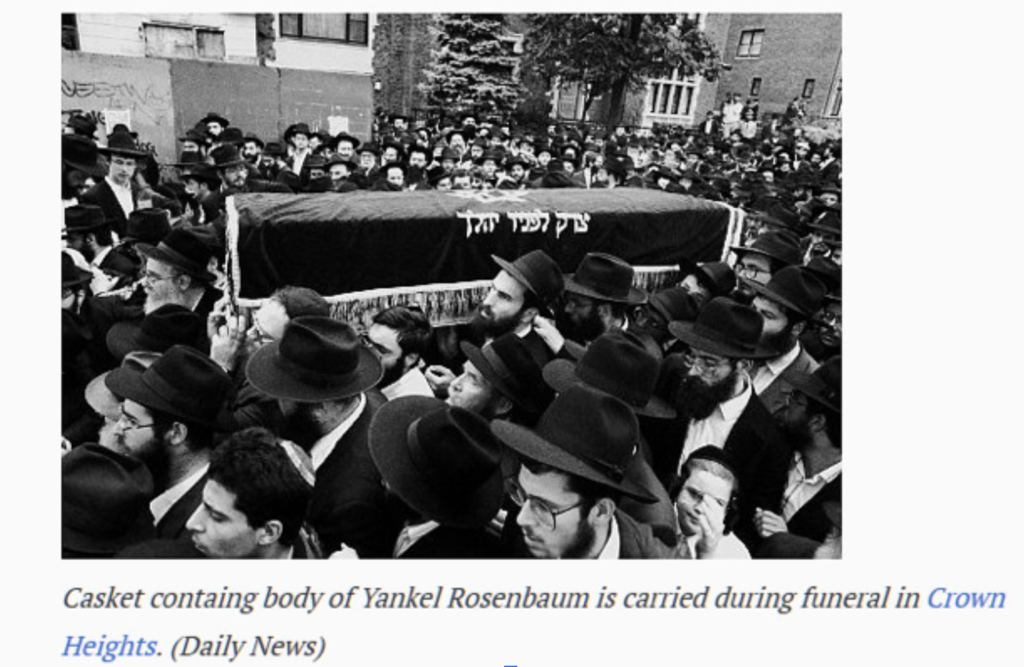
These two tragic deaths, strained tense race relations in the city and reverberated beyond the city limits.
Ultimately, African American and Jewish leaders developed an outreach program between communities to help calm and hopefully improve race relations in Crown Heights and beyond.
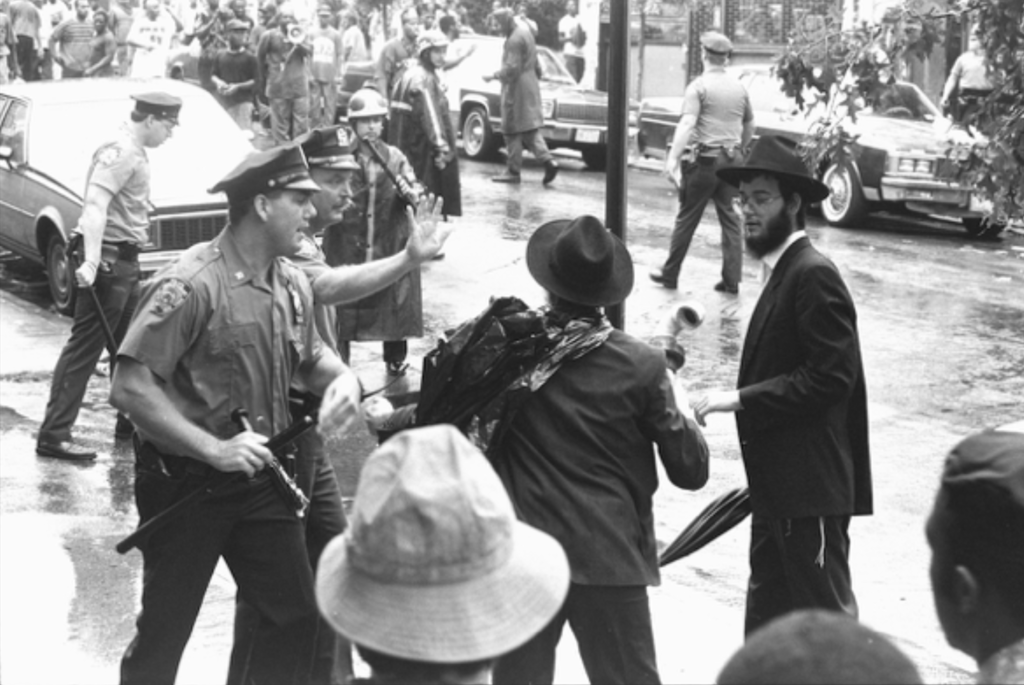
New Anti-Semitism
In recent decades, anti-Semitic hate has shifted forms and adapted to the interconnected world we live in today. The internet makes it easy for individuals all over the world to quickly and easily spread their messages of hate and bigotry with the click of a button. This paired with other technological changes, such as advancements in transportation, have energized anti-Semites who can now easily convene physically and virtually.

A shift in global anti-Semitism has come in what scholars are calling “New Anti-Semitism”. To disguise their hate online and reach the broadest possible audience, anti-Semites have camouflaged their hate against Jews as hate against the Jewish state. Age old anti-Semitic tropes, such as ‘Jew’s using their money to control world events’, have been shifted by anti-Semites to be “legitimate” criticisms of Israeli “influence peddling”.
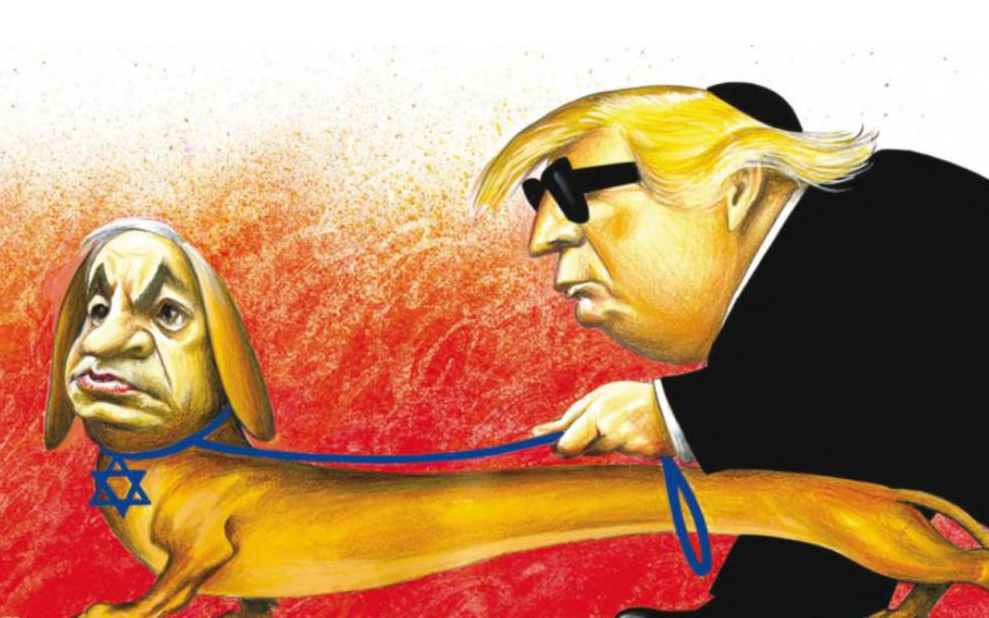
While criticisms of the State of Israel can in fact be legitimate and not anti-Semitic, singling out the world’s only Jewish state with criticisms not levied on other countries, is textbook anti-Semitism. Unfortunately, these ideas have grown in prominence in recent years, and anti-Semitic tropes have been used from the darkest depths of the internet to the halls of the United States Congress.
Consensus among experts is that general anti-Semitic sentiment had been on the decline for much of the second half of the twentieth and into the twenty-first century, however a recent surge in anti-Semitic violence globally has shocked many. Emboldened by internet followers and online message boards, anti-Semites have perpetrated a number of vicious crimes recently. From domestic terrorism to Swastika graffiti and vandalism across all fifty states, Jews must live in fear that they will be the next hate crime victim.
College Campuses
In a rather unsettling trend, anti-Semitism has found a home to flourish on college campuses across our nation. Many of these ideas are espoused in the name of progressivism, but are ‘wolves in sheep’s clothing’ and are being peddled by vicious anti-Semites. One of the key groups responsible for the propagation of these anti-Semitic ideas is Students for Justice in Palestine (SJP). This bigoted organization is looking for anything but justice and wants to see the Jewish population of Israel destroyed. They don’t hide this desire, chanting “from the river to the sea, Palestine will be free”, or in other words they hope to cast the State of Israel and its Jewish population into the sea.
One such idea that has entrenched itself in college circles is support for the BDS (Ban, Divest, & Sanction) movement. The BDS movement seeks to starve out and destroy Israel and it’s Jewish population through a boycott of its products and divestitures from Israeli businesses. BDS seeks to delegitimize Israel as a free nation of the world, which according to President Barack Obama’s State Department, is anti-Semitic. BDS has gained solid ground on campuses disguised as a social justice movement by painting Israel as an oppressor, but refuses to acknowledge the Palestinian’s violence and terrorism that is a major contribution to the Middle East conflict.
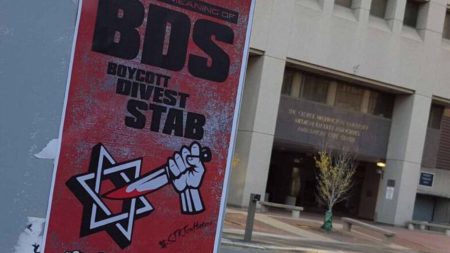
Another area of particular concern is anti-Semitic graffiti and vandalism on college campuses. These crimes have been popping up with an increased frequency in recent years because of the speed and ease in which perpetrators can spread their messages of hate. The Anti-Defamation League, an organization that tracks acts of anti-Semitism globally, recorded an 89% increase in anti-Semitic incidents (harassment, vandalism, graffiti, assaults) on campuses across the US in 2017. Universities are places to spread ideas and unfortunately, anti-Semites and bigots have used that to their advantage by inserting themselves into campus dialogue and spreading messages of hate to an impressionable youth.
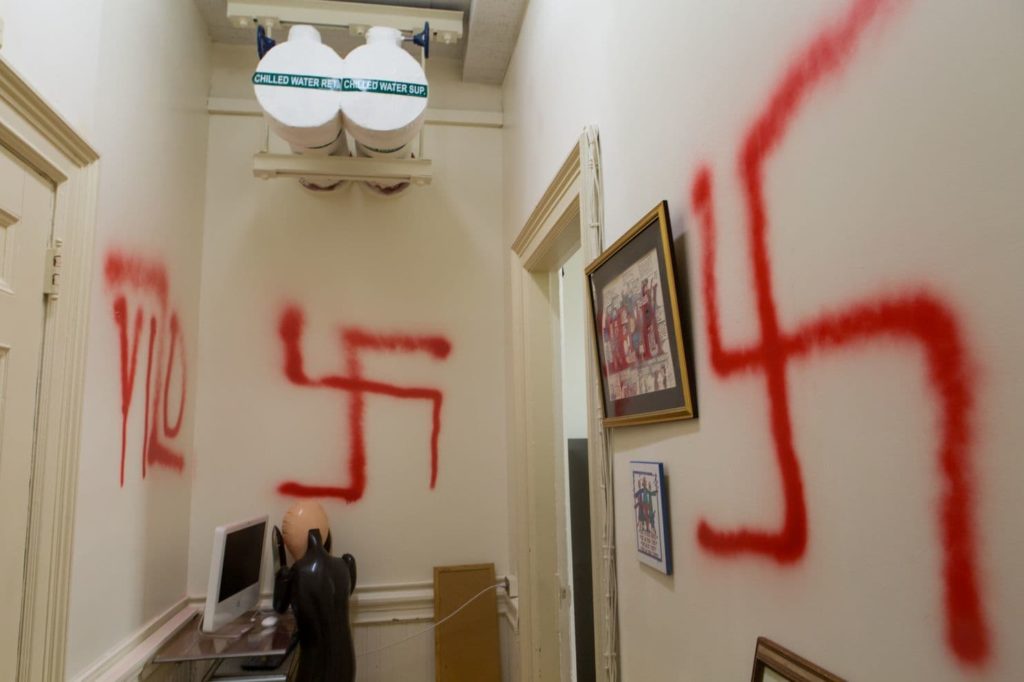
Synagogue Shootings
On October 27th 2018, the deadliest anti-Semitic attack against American Jews took place. Members of the Tree of Life synagogue were convened for Saturday Shabbat services when a vehemently anti-Semitic shooter burst in.
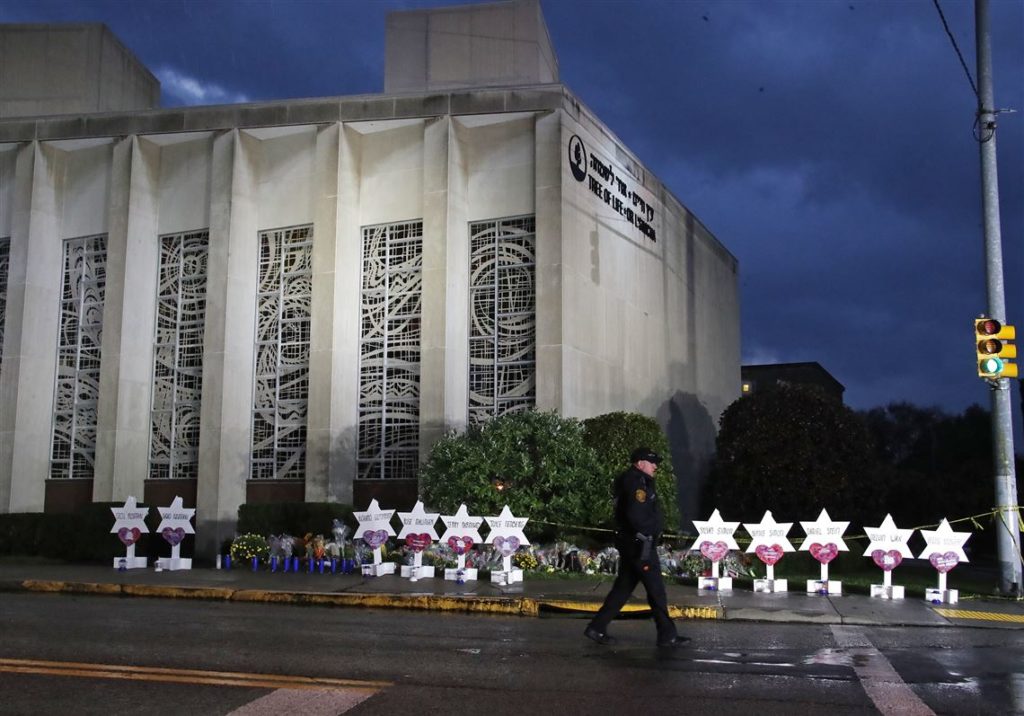
Eleven members of the congregation were slaughtered for the simple “crime” of being Jewish. Sadly, many of those who were killed had survived the atrocities of holocaust only to be killed in a hate crime at home in America.
After the shooting, it was revealed that the perpetrator was heavily influenced by anti-Semitic behavior online. His social media footprint was filled with vile sentiments about Jews, and used many classic anti-Semitic tropes and conspiracy theories to dispagarage them. In the time shortly before the attack he even posted on the internet about the “Jewish invaders” and hinted at his intention to “do something about it”. As he was being taken into police custody the shooter expressed his desire for “all Jews to die”.
Inspired by the Tree of Life massacre, a second anti-Semitic shooting took place in a Chabad center in Poway, California on April 27th 2019, 6 months to the day of the first shooting. Just as in the last, Jews were gathered for Saturday prayer when the shooter stormed the synagogue.
One woman was killed in the attack but thankfully the bravery and quick thinking of a few congregants mitigated further fatalities as they fought off the shooter who then fled before he could inflict anymore damage. Just as in the last, this shooter had an anti-Semitic footprint online, even having posted a manifesto disparaging Jews and spreading a message of hate on the internet hours before the shooting.
Anti-Semitism is a racist ideology as old as biblical times, and it will not be easy to defeat. With new tools available and adaptations to technological advancements, anti-Semites are able to spread their racist ideology easier and more quickly than ever before. We need strong leadership now more than ever to stand united against the hate.
Only together, can we defeat anti-Semitism!
2010 State Department Defines Anti-Semitism
On June 8, 2010, President Obama’s State Department released a memo defining the term anti-Semitism.
Definition of anti-Semitism
Anti-Semitism is a certain perception of Jews, which may be expressed as hatred toward Jews. Rhetorical and physical manifestations of anti-Semitism are directed toward Jewish or non-Jewish individuals and/or their property, toward Jewish community institutions and religious facilities.
Manifestations might include the targeting of the state of Israel, conceived as a Jewish collectivity. However, criticism of Israel similar to that leveled against any other country cannot be regarded as anti-Semitic. Anti-Semitism frequently charges Jews with conspiring to harm humanity, and it is often used to blame Jews for “why things go wrong.” It is expressed in speech, writing, visual forms and action, and employs sinister stereotypes and negative character traits.
Contemporary examples of anti-Semitism in public life, the media, schools, the workplace, and in the religious sphere could, taking into account the overall context, include, but are not limited to:
Calling for, aiding, or justifying the killing or harming of Jews in the name of a radical ideology or an extremist view of religion.
Making mendacious, dehumanizing, demonizing, or stereotypical allegations about Jews as such or the power of Jews as collective — such as, especially but not exclusively, the myth about a world Jewish conspiracy or of Jews controlling the media, economy, government or other societal institutions.
Accusing Jews as a people of being responsible for real or imagined wrongdoing committed by a single Jewish person or group, or even for acts committed by non-Jews.
Denying the fact, scope, mechanisms (e.g. gas chambers) or intentionality of the genocide of the Jewish people at the hands of National Socialist Germany and its supporters and accomplices during World War II (the Holocaust).
Accusing the Jews as a people, or Israel as a state, of inventing or exaggerating the Holocaust.
Accusing Jewish citizens of being more loyal to Israel, or to the alleged priorities of Jews worldwide, than to the interests of their own nations.
Denying the Jewish people their right to self-determination, e.g., by claiming that the existence of a State of Israel is a racist endeavor.
Applying double standards by requiring of it a behavior not expected or demanded of any other democratic nation.
Using the symbols and images associated with classic antisemitism (e.g., claims of Jews killing Jesus or blood libel) to characterize Israel or Israelis.
Drawing comparisons of contemporary Israeli policy to that of the Nazis.
Holding Jews collectively responsible for actions of the state of Israel.
Today
Today, anti-Semitism has crept it’s way into our mainstream culture, our media, and our politics. This year, two newly elected members of Congress started spewing hateful and anti-Semitic rhetoric, without condemnation from their colleagues.

Ilhan Omar:
anti-Semitic poster child.
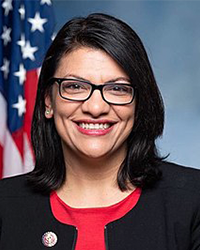
Rashida Tlaib:
Hateful Rhetoric.
